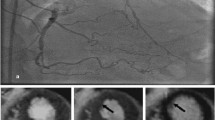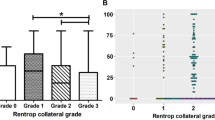Abstract
(1) To assess extracellular volume fraction (ECV) and regional systolic function in patients presenting with coronary chronic total occlusion (CTO) in areas without significant late gadolinium enhancement (LGE), and (2) to investigate the correlation between angiography collateral flow and ECV in territories supplied by CTO vessels. A total of 50 angiographically documented CTO patients and 15 age- and sex-matched normal controls were recruited to the study. Myocardial ECV, was calculated in infarcted, global non-infarcted and the entire myocardium respectively. Segmental ECV was calculated from myocardial segments within the perfusion territory of a CTO vessel. The global and regional systolic function was evaluated using ejection fraction and percent systolic thickening. ECVs in global myocardium and global non-infarcted myocardium were significantly elevated in comparison with that in controls (29.1 ± 4.2 % and 26.6 ± 2.6 % vs. 23.3 ± 2.0 %, all P < 0.005). Global ECV significantly correlated with LV ejection fraction (r = −0.56, P < 0.001) and ECV inversely correlated with systolic thickening in global non-infarcted myocardium (r = −0.31, P < 0.05). The lower segmental ECV was associated with the presence of well-developed collaterals (P = 0.004), and multivariate binary logistic analysis demonstrated that mean segmental ECV and course of disease were the independent discriminator of collateral flow with overall diagnostic accuracy of 74.4 %. In patients with CTO, ECV is found to be increased beyond that observed with LGE, and correlates with LV regional wall motion abnormality, which appears to reflect diffuse myocardial fibrosis. Mean segmental ECV value, combined with course of disease, may serve as good predictors of collateral flow.





Similar content being viewed by others
Abbreviations
- ECV:
-
Extracellular volume fraction
- CTO:
-
Chronic total occlusion
- LGE:
-
Late gadolinium enhancement
- DMF:
-
Diffuse myocardial fibrosis
- CMR:
-
Cardiovascular magnetic resonance
- MI:
-
Myocardial infarction
- MYO:
-
Myocardium
- EF:
-
Ejection fraction
- MOLLI:
-
Modified Look-Locker Inversion Recovery
- TIMI:
-
Thrombolysis in myocardial infarction grade
References
Brilakis ES, Karmpaliotis D, Vo MN, Garcia S, Michalis L, Alaswad K, Doshi P, Lombardi WL, Banerjee S (2014) Advances in the management of coronary chronic total occlusions. J Cardiovasc Transl Res 7:426–436
Galla JM, Whitlow PL (2010) Coronary chronic total occlusion. Cardiol Clin 28:71–79
White SK, Sado DM, Flett AS, Moon JC (2012) Characterising the myocardial interstitial space: the clinical relevance of non-invasive imaging. Heart 98:773–779
Chan W, Duffy SJ, White DA, Gao X, Du X, Ellims AH, Dart AM, Taylor AJ (2012) Acute left ventricular remodeling following myocardial infarction: coupling of regional healing with reomote extracellular matrix expansion. JACC Cardiovasc Imaging 5:884–893
Mewton N, Liu CY, Croisille P, Bluemke D, Lima JAC (2011) Assessment of myocardial fibrosis with cardiovascular magnetic resonance. J Am Coll Cardiol 57:891–903
Ugander M, Oki AJ, Hsu LY, Kellman P, Greiser A, Aletras AH, Sibley CT, Chen MY, Bandettini WP, Arai AE (2012) Extracellular volume imaging by magnetic resonance imaging provides insights into overt and sub-clinical myocardial pathology. Eur Heart J 33:1268–1278
Wong TC, Piehler KM, Kang IA, Kadakkal A, Kellman P, Schwartzman DS, Mulukutla SR, Simon MA, Shroff SG, Kuller LH, Schelbert EB (2014) Myocardial extracellular volume fraction quantified by cardiovascular magnetic resonance is increased in diabetes and associated with mortality and incident heart failure admission. Eur Heart J 35:657–664
Hong YJ, Park CH, Kim YJ, Hur J, Lee HJ, Hong SR, Suh YJ, Greiser A, Paek MY, Choi BW, Kim TH (2015) Extracellular volume fraction in dilated cardiomyopathy patients without obvious late gadolinium enhancement: comparison with healthy control subjects. Int J Cardiovasc Imaging. doi:10.1007/s10554-015-0595-0
Dusenbery SM, Jerosch-Herold M, Rickers C, Colan SD, Geva T, Newburger JW, Powell AJ (2014) Myocardial extracellular remodeling is associated with ventricular diastolic dysfunction in children and young adults with congenital aortic stenosis. J Am Coll Cardiol 63:1778–1785
Thuny F, Lovric D, Schnell F, Bergerot C, Ernande L, Cottin V, Derumeaux G, Croisille P (2014) Quantification of myocardial extracellular volume fraction with cardiac MR imaging for early detection of left ventricle involvement in systemic sclerosis. Radiology 271:373–380
Ntusi NA, Piechnik SK, Francis JM, Ferreira VM, Matthews PM, Robson MD, Wordsworth PB, Neubauer S, Karamitsos TD (2015) Diffuse myocardial fibrosis and inflammation in rheumatoid arthritis: insights from CMR T1 mapping. JACC Cardiovasc Imaging. doi:10.1016/j.jcmg.2014.12.025
Flett AS, Hayward MP, Ashworth MT, Hansen MS, Taylor AM, Elliott PM, McGregor C, Moon JC (2010) Equilibrium contrast cardiovascular magnetic resonance for the measurement of diffuse myocardial fibrosis: preliminary validation in humans. Circulation 122:138–144
Miller CA, Naish JH, Bishop P, Coutts G, Clark D, Zhao S, Ray SG, Yonan N, Williams SG, Flett AS, Moon JC, Greiser A, Parker GJ, Schmitt M (2013) Comprehensive validation of cardiovascular magnetic resonance techniques for the assessment of myocardial extracellular volume. Circ Cardiovasc Imaging 6:373–383
Pohl T, Seiler C, Billinger M, Herren E, Wustmann K, Mehta H, Windecker S, Eberli FR, Meier B (2001) Frequency distribution of collateral flow and factors influencing collateral channel development. Functional collateral channel measurement in 450 patients with coronary artery disease. J Am Coll Cardiol 38:1872–1878
Zhang J, Li Y, Li M, Pan J, Lu Z (2014) Collateral vessel opacification with CT in patients with coronary total occlusion and its relationship with downstream myocardial infarction. Radiology 271:703–710
Choi JH, Chang SA, Choi JO, Song YB, Hahn JY, Choi SH, Lee SC, Lee SH, Oh JK, Choe Y, Gwon HC (2013) Frequency of myocardial infarction and its relationship to angiographic collateral flow in territories supplied by chronically occluded coronary arteries. Circulation 127:703–709
Kellman P, Wilson JR, Xue H, Bandettini WP, Shanbhag SM, Druey KM, Ugander M, Arai AE (2012) Extracellular volume fraction mapping in the myocardium, part 2: initial clinical experience. J Cardiovasc Magn Reson 14:64
Cerqueira MD, Weissman NJ, Dilsizian V, Jacobs AK, Kaul S, Laskey WK, Pennell DJ, Rumberger JA, Ryan T, Verani MS (2002) Standardized myocardial segmentation and nomenclature for tomographic imaging of the heart. A statement for healthcare professionals from the Cardiac Imaging Committee of the Council on Clinical Cardiology of the American Heart Association. Circulation 105:539–542
Kim RJ, Wu E, Rafael A, Chen EL, Parker MA, Simonetti O, Klocke FJ, Bonow RO, Judd RM (2000) The use of contrast-enhanced magnetic resonance imaging to identify reversible myocardial dysfunction. N Engl J Med 343:1445–1453
Dall’Armellina E, Piechnik SK, Ferreira VM, Si QL, Robson MD, Francis JM, Cuculi F, Kharbanda RK, Banning AP, Choudhury RP, Karamitsos TD, Neubauer S (2012) Cardiovascular magnetic resonance by non contrast T1-mapping allows assessment of severity of injury in acute myocardial infarction. J Cardiovasc Magn Reson 14:15
Stone GW, Kandzari DE, Mehran R, Colombo A, Schwartz RS, Bailey S, Moussa I, Teirstein PS, Dangas G, Baim DS, Selmon M, Strauss BH, Tamai H, Suzuki T, Mitsudo K, Katoh O, Cox DA, Hoye A, Mintz GS, Grube E, Cannon LA, Reifart NJ, Reisman M, Abizaid A, Moses JW, Leon MB, Serruys PW (2005) Percutaneous recanalization of chronically occluded coronary arteries: a consensus document: Part I. Circulation 112:2364–2372
Jellis C, Wright J, Kennedy D, Sacre J, Jenkins C, Haluska B, Martin J, Fenwick J, Marwick TH (2011) Association of imaging markers of myocardial fibrosis with metabolic and functional disturbances in early diabetic cardiomyopathy. Circ Cardiovasc Imaging 4:693–702
Messroghli DR, Nordmeyer S, Dietrich T, Dirsch O, Kaschina E, Savvatis K, Klein C, Berger F, Kuehne T (2011) Assessment of diffuse myocardial fibrosis in rats using small-animal Look-Locker inversion recovery T1 mapping. Circ Cardiovasc Imaging 4:636–640
Stuckey DJ, McSweeney SJ, Thin MZ, Habib J, Price AN, Fiedler LR, Gsell W, Prasad SK, Schneider MD (2014) T1 mapping detects pharmacological retardation of diffuse cardiac fibrosis in mouse pressure-overload hypertrophy. Circ Cardiovasc Imaging 7:240–249
Iles L, Pfluger H, Phrommintikul A, Cherayath J, Aksit P, Gupta SN, Kaye DM, Taylor AJ (2008) Evaluation of diffuse myocardial fibrosis in heart failure with cardiac magnetic resonance contrast-enhanced T1 mapping. J Am Coll Cardiol 52:1574–1580
Bull S, White SK, Piechnik SK, Flett AS, Ferreira VM, Loudon M, Francis JM, Karamitsos TD, Prendergast BD, Robson MD, Neubauer S, Moon JC, Myerson SG (2013) Human non-contrast T1 values and correlation with histology in diffuse fibrosis. Heart 99:932–937
Ellims AH, Shaw JA, Stub D, Iles LM, Hare JL, Slavin GS, Kaye DM, Taylor AJ (2014) Diffuse myocardial fibrosis evaluated by post-contrast T1 mapping correlates with left ventricular stiffness. J Am Coll Cardiol 63:1112–1118
Ellims AH, Iles LM, Ling LH, Hare JL, Kaye DM, Taylor AJ (2012) Diffuse myocardial fibrosis in hypertrophic cardiomyopathy can be identified by cardiovascular magnetic resonance, and is associated with left ventricular diastolic dysfunction. J Cardiovasc Magn Reson 14:76
Kellman P, Hansen MS (2014) T1-mapping in the heart: accuracy and precision. J Cardiovasc Magn Reson 16:2
Brilla CG, Funck RC, Rupp H (2000) Lisinopril-mediated regression of myocardial fibrosis in patients with hypertensive heart disease. Circulation 102:1388–1393
Wong TC, Piehler K, Meier CG, Testa SM, Klock AM, Aneizi AA, Shakesprere J, Kellman P, Shroff SG, Schwartzman DS, Mulukutla SR, Simon MA, Schelbert EB (2012) Association between extracellular matrix expansion quantified by cardiovascular magnetic resonance and short-term mortality. Circulation 126:1206–1216
Billinger M, Kloos P, Eberli FR, Windecker S, Meier B, Seiler C (2002) Physiologically assessed coronary collateral flow and adverse cardiac ischemic events: a follow-up study in 403 patients with coronary artery disease. J Am Coll Cardiol 40:1545–1550
Acknowledgments
This work was supported by the National Natural Science Foundation of China (Grant Number 81201070) and Fudan University Foundation for young teachers to improve scientific research ability (Grant Number 20520133486).
Conflict of interest
None.
Author information
Authors and Affiliations
Corresponding authors
Rights and permissions
About this article
Cite this article
Chen, Y.Y., Zhang, W.G., Yang, S. et al. Extracellular volume fraction in coronary chronic total occlusion patients. Int J Cardiovasc Imaging 31, 1211–1221 (2015). https://doi.org/10.1007/s10554-015-0680-4
Received:
Accepted:
Published:
Issue Date:
DOI: https://doi.org/10.1007/s10554-015-0680-4




